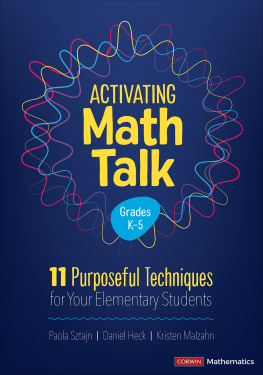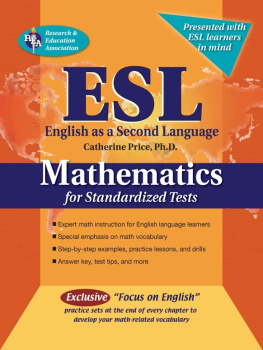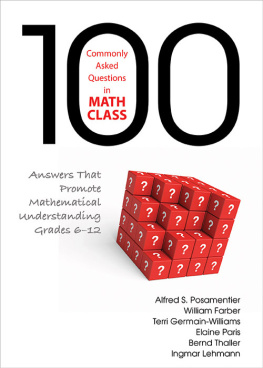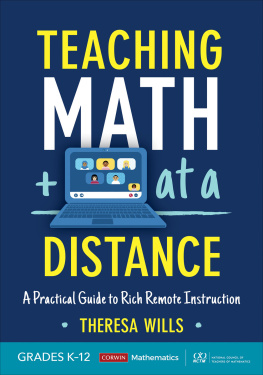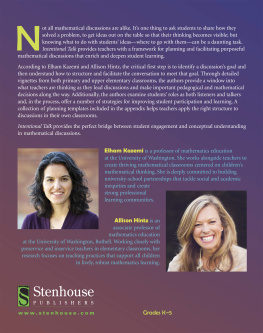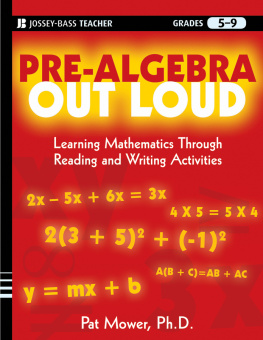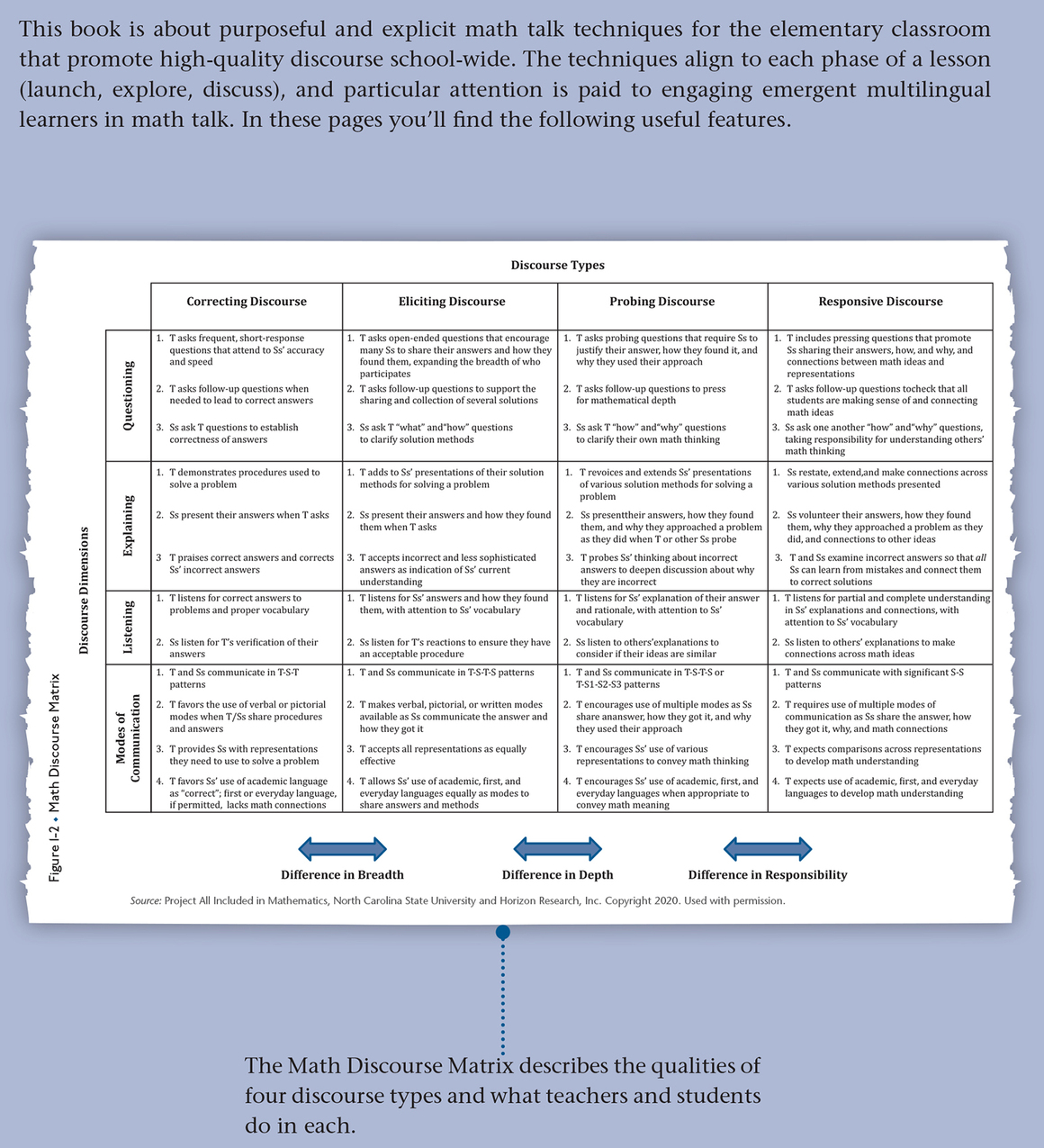What Your Colleagues Are Saying
This book provides the perfect answer to the question, How can I help students engage in high-quality math discourse in my classroom? The experiences of real teachers in real classrooms, brought to life through a series of vignettes, provide vivid illustrations of how the 11 techniques described can get students thinking and talking about mathematics. The book is a game changer for elementary teachers!
Margaret (Peg) Smith
Emeritus Faculty, University of Pittsburgh
Weve come a long way since discussion in math class meant that individual students shared their strategies one after the other with little interaction or reflection. This book is based on the premise that discourse skills can and must be learned and practiced if all students are to have access to participation in high-quality talk about significant mathematical ideas. Based on a decade of work with teachers and coaches, it provides clear, specific strategies illustrated with classroom examples for supporting students as they learn how to talk, listen, and question during all phases of the math lesson.
Susan Jo Russell
Senior Researcher, TERC
Packed with powerful teaching ideasthere are so many excellent teaching strategies in this single book! A teacher could learn to implement one or two of these techniques and the book will have been worth its cost. It provided ideas that I wanted to try to implement RIGHT AWAY!
Amanda Jansen
Professor of Mathematics Education
University of Delaware
This book does a great job of providing how-to steps that I was able to incorporate into my own practice. These techniques for discourse are appropriate for a wide variety of grade and skill levels. I especially appreciated the strategies for differentiation and for meeting the needs of emergent multilinguals.
Tyler Erickson
Fifth-Grade Teacher
We teachers know students can talk. But teaching how to talk to further mathematical understanding is challenging. Activating Math Talk gave me strategies to guide students, even reticent ones, into meaningful mathematical discourse. It challenged me to be more purposeful in opening spaces for students to surprise you. It changed the way I taught and listened to students, making me a better teacher, and helped me create an exciting, respectful classroom environment where my students gained confidence and competence in building shared mathematical understanding.
Kim Zeugner
Elementary Teacher
Fostering a discourse-rich classroom is essential for emergent multilingual learners to develop deep understandings of mathematics. The authors provide the what, why, and how of developing meaningful learning communities through practical, research-based suggestions that teachers can take directly into their classrooms. The inclusion of excerpts from real classrooms allows us insights into the teachers and learners experiences as we learn how to center and foster language in the mathematics classroom. This book is a great resource for teachers and teacher educators who wonder how to help move the math forward while students are acquiring language.
Zandra de Araujo
Associate Professor of Mathematics Education
University of Missouri
This book is set up well for grade-level teams to do a book study and set goals for how they are working towards creating a discourse community in their classrooms.
Joshua Males
K12 Mathematics Curriculum Specialist
This is a needed resource right now. We teachers just arent doing this in our classrooms and we need a resource to develop this aspect of our instruction.
Kyle Cayce
Elementary Teacher
Activating Math Talk: The Book at a Glance
Descriptions of Images and Figures
Activating Math Talk: The Book at a Glance
Page iii
An image of page 9 appears, with text extending from Figure 12: Math Discourse Matrix. The table has three double-headed arrows under it, labeled Difference in Breadth, Difference in Depth, and Difference in Responsibility.
Text extending from the page 9 thumbnail reads as follows: The Math Discourse Matrix describes the qualities of four discourse types and what teachers and students do in each.
Page iv
Images of portions of pages 7 and 26 appear, with text extending from several sections of them.
Text extending from the Think About It note and the definition of Math discourse in the margin of page 7 reads as follows: Throughout the book, find definitions of key terms and opportunities to consider how key points or nuances relate to your own instruction.
Text extending from the task boxes on page 26 reads as follows: Learn how to analyze how well your math tasks promote or limit math discourse, and find many examples of high-quality tasks.
Page v
Images of portions of pages 63 and 87 appear, with text extending from each.
Text extending from the image of page 63, which includes a magnifying glass icon, reads as follows: Examine Practice scenarios provide opportunities to analyze and reflect on the implementation of talk techniques in authentic elementary classrooms.
Text extending from the page 87 image, which includes a high-five icon and an exclamation mark icon, reads as follows: Signs of Success and Caution Signals highlight indicators of successful technique implementation and foreshadow potential challenges that might arise.
Page vi
Images of portions of page 94 and two portions of page 13 with text extending from each.
Text extending from the page 94 image, which includes an icon that has two stars superimposed, reads as follows: Key Takeaways help summarize the most salient points from each lesson phase.
Text extending from the first page 13 image, which includes a dialog icon, reads as follows: Discuss With Colleagues sections help you reflect on your practice as a team.
Text extending from the second page 13 image, which includes a jigsaw puzzle icon, reads as follows: Connect to Your Practice sections give you opportunities to apply and reflect on a new skill.
Activating Math Talk
Grades K5
11 Purposeful Techniques for Your Elementary Students
- Paola Sztajn
- Daniel Heck
- Kristen Malzahn
Copyright 2021 by Paola Sztajn and Horizon Research, Inc.
All rights reserved. Except as permitted by U.S. copyright law, no part of this work may be reproduced or distributed in any form or by any means, or stored in a database or retrieval system, without permission in writing from the publisher.
When forms and sample documents appearing in this work are intended for reproduction, they will be marked as such. Reproduction of their use is authorized for educational use by educators, local school sites, and/or noncommercial or nonprofit entities that have purchased the book.
All third party trademarks referenced or depicted herein are included solely for the purpose of illustration and are the property of their respective owners. Reference to these trademarks in no way indicates any relationship with, or endorsement by, the trademark owner.
This material is based upon work supported by the National Science Foundation under Grant Nos. EHR-1513155, EHR-1513104 and EHR-1020177. Any opinions, findings and conclusions or recommendations expressed in this material are those of the author(s) and do not necessarily reflect the views of the National Science Foundation.

